Thinking Routines for Deeper Understanding
Explore thinking routines: simple questions that reveal student thought and deepen learning, with tips to embed them across subjects.


Explore thinking routines: simple questions that reveal student thought and deepen learning, with tips to embed them across subjects.
It all started with Project Zero’s Visible Thinking initiative, a fascinating effort by researchers at Harvard’s Graduate School of Education. These routines have not only been instrumental but remarkably effective in nurturing student thinking across diverse backgrounds and disciplines.
While they may sound complex, these routines are essentially sets of questions or simple sequences. They scaffold and support thinking, and in time, become integral to classroom culture. This deliberate naming - thinking routines captures their essence as ingrained and socially shared practices. Their purpose? To create environments where thinking is not just encouraged but visibly celebrated and embedded in learning.
The thinking routines toolbox definines thinking routines as sequences of questions or steps that guide students in their thought processes. Intriguingly, it categorizes these routines into Core Thinking and Possibilities, along with various other methods for organizing and synthesizing ideas, creating a structured yet flexible framework.
With over 80 routines available, educators can adapt them to fit different educational settings. Think of it as a toolkit designed to make thinking more visible, encouraging a deeper connection with the content. This toolbox, a true resource by Project Zero, transforms the very fabric of classroom learning, promoting understanding and engagement.
The journey began with Project Zero researchers at Harvard’s Graduate School of Education, driven by a desire to support and scaffold student thinking. By using a set of questions or a sequence of steps, these routines make the invisible processes of thinking visible, enhancing students' cognitive abilities.
The Thinking Routines Toolbox, an integral part of this evolution, offers diverse types like Core Thinking Routines and systems for deepening student understanding. Teachers play a crucial role here, as these routines help them uncover students’ thought processes, enabling students to identify and apply specific thinking moves across various contexts.
These routines don’t just stay within the confines of a subject like English; they are versatile, fostering deeper understanding and facilitating communication across disciplines. Isn’t it fascinating how something so structured can offer such dynamic flexibility?
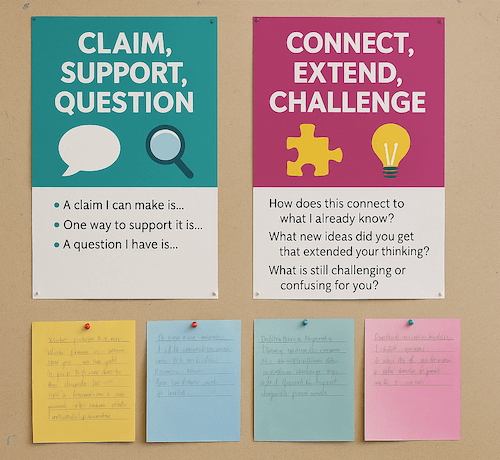
Thinking routines present themselves as a dynamic tool within educational settings, especially when trying to foster a culture of deeper learning and critical thinking among students. They are specifically designed to scaffold student thinking, creating avenues through which learners can explore and articulate their thoughts in varied and meaningful ways.
By employing these routines, educators can visibly illuminate the cognitive processes occurring within their classrooms, thereby allowing for a more inclusive and interactive learning environment. Adaptable across different subjects and grade levels, thinking routines offer the flexibility necessary to cater to the diverse needs of students, enhancing overall engagement and understanding.
Their structured yet flexible nature empowers students from all backgrounds and abilities to engage in open discussions and promote a culture where thinking becomes a visible and integral part of the learning process.
When we talk about enhancing critical thinking in education, the role of thinking routines becomes quite significant. These routines are meticulously crafted to make the thinking processes explicit and visible to students as they navigate through various learning challenges.
By actively participating in these thinking routines, students cultivate critical thinking skills, which are essential for analyzing complex concepts and making informed decisions. Over time, thinking routines grow alongside the student, progressively guiding them toward deeper and more advanced levels of thinking.
They provide educators with a framework to nurture a classroom atmosphere predisposed to inquiry, scrutiny, and intellectual engagement. Moreover, the flexibility of these routines means they can be applied across different subjects, ensuring that the prowess of critical thinking is a consistent thread throughout a student's learning journey.
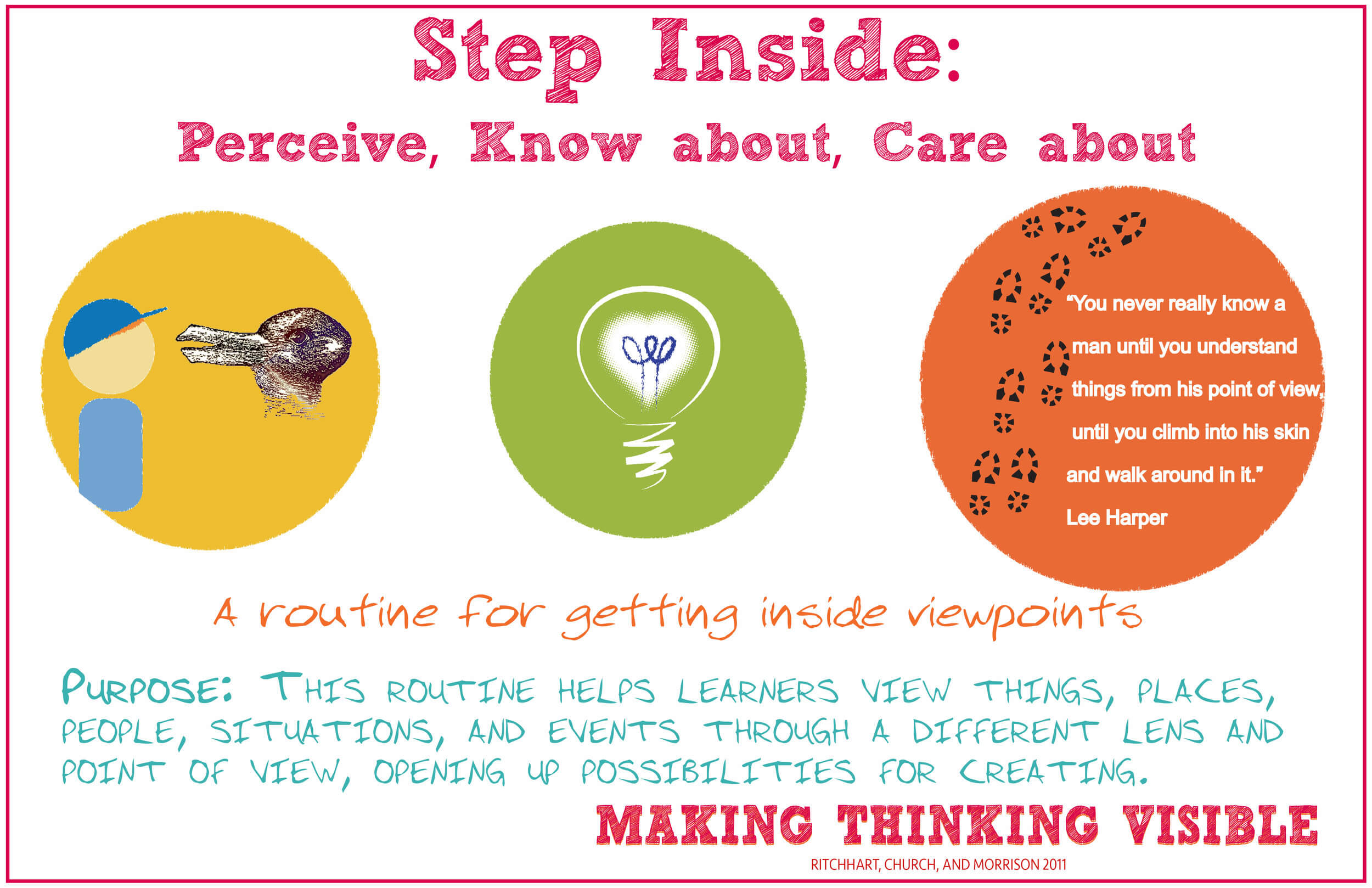
Students who feel engaged are, in turn, more capable of exploring and reflecting on their learning experiences in a substantial way. Thinking routines serve as an essential tool in nurturing this engagement. Project Zero’s extensive research highlights their applicability across diverse age groups and academic disciplines - an important feature of these routines. By structuring student thinking toward progressively more intricate analyses, these routines invite learners to delve deeper into the learning process.
The goal here is simple yet profound: make student thinking visible. This visibility acts as a platform where students can showcase their capabilities, demonstrating not just what they know but how they think. When these routines are effectively integrated into the fabric of a classroom, they can consequently transform the cultural forces at play. There is a ripple effect - shaping language use, increasing respectful exchanges of ideas, and opening the floor to more authentic learning opportunities for every student involved.
As students use these routines, they begin to notice, understand, and consciously apply specific thinking moves, equipping them with valuable tools that can be transferred across different contexts.
The impact of successfully integrating thinking routines extends beyond mere comprehension; indeed, it fosters an educational culture where critical and creative thinking are not just encouraged but seen as everyday necessities. The scaffolding nature of these routines helps students transition from a more structured phase of thinking into a fluid, independent expression of ideas.
By emphasizing the importance of thinking beyond facts and fostering critical insights, thinking routines lay the groundwork for an enriching learning environment. Whether grappling with a mathematical concept or exploring historical narratives, these routines guide students toward a future where thinking is both visible and appreciated in every aspect of their academic journey.
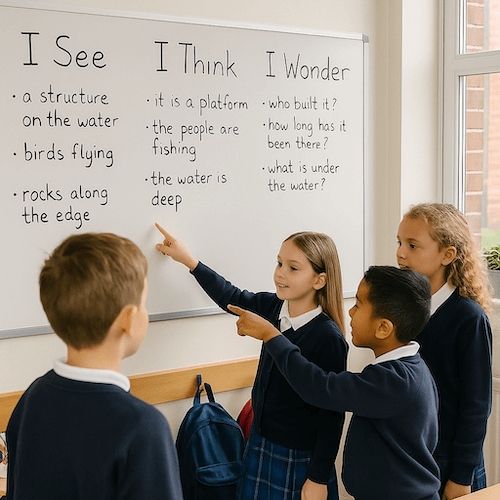
Teachers who adopt Visible Thinking know that short, repeatable moves can make thinking visible, nurture positive thinking dispositions, and strengthen creative thinking skills across a wide variety of contexts. Inspired by Ron Ritchhart, these simple routines slot into any lesson, any year group, and virtually all subject matters. Below you’ll find nine of the most widely used visible thinking routines - each one a simple structure that pairs “thinking with content learning” and supports the ongoing development of students.
When embedded consistently, these Visible Thinking Strategies help cultivate Cultures of Thinking in which learners question, connect, and create—turning classrooms into communities where knowledge and thinking grow side by side.
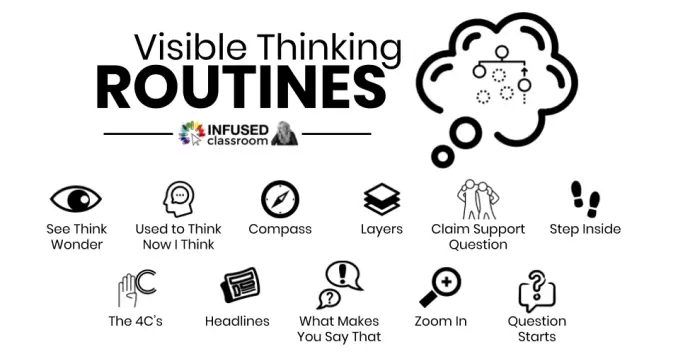
While the routines are structured to guide thinking, they also remain adaptable, providing the flexibility needed to tie thinking directly to content and purpose. In essence, they serve as tools for achieving learning goals, rather than being objectives in themselves.
In English Language Teaching (ELT) classrooms, thinking routines are invaluable for enhancing and supporting students' learning experiences across different grades and content areas. By integrating these routines, teachers can shift the focus from mere absorption of information to fostering a deeper understanding of the material. These routines guide learners' cognitive processes through structured questions, leading to more engaging and comprehensive discussions.
As students delve into ELT resources, thinking routines help reveal and cultivate their unique thinking patterns. This insight is beneficial for both educators and students, enabling them to refine their learning strategies across various contexts. Ultimately, the consistent use of thinking routines in ELT settings encourages a culture of thoughtful inquiry and exploration.
Addressing adaptations for the writing process using thinking routines requires connecting their structured approach to creative and critical thinking. When learners embark on writing, these routines can guide brainstorming, organizing ideas, and refining drafts. The gradual and structured nature of thinking routines can help writers pause and reflect, allowing them to explore different perspectives before committing words to paper.
This is not just about producing text; it's about expanding their cognitive structures around what they wish to communicate. By focusing on the journey of writing rather than merely the destination, these routines can help develop writers who think deeply and articulate their ideas clearly, though specific adaptations still require individual exploration.
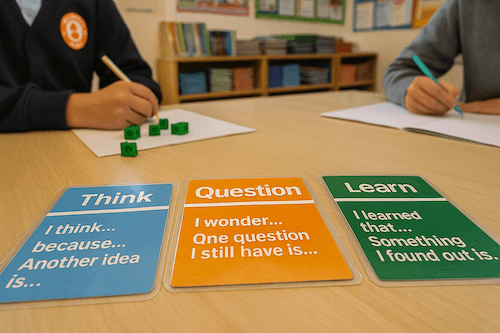
Thinking routines are particularly well-suited for online learning environments, providing a sense of structure and consistency that students can rely upon. In virtual settings, where traditional cues and interactions may be absent, these routines become a familiar anchor.
Schedules can feel disrupted online, so having a structured approach to thinking ensures that learners remain engaged, focusing on content in meaningful ways. By creating a sequence of steps or questions, they're not left aimlessly navigating unfamiliar terrain. Furthermore, teachers using these routines can gain vital insights into their students' thought processes, which are crucial for offering the right support remotely.
As students connect, question, and challenge the material presented digitally, they hone critical thinking skills in a way that mirrors, yet extends beyond, the physical classroom experience. Online, these routines help cultivate an independent yet guided form of learning.
When integrating thinking routines into classroom practice, teachers are tasked with more than just introducing a new activity or tool. They must consider both their own understanding and their students’ developmental phases. This requires an insightful approach to scaffold students' thinking effectively.
One notable challenge is ensuring that thinking routines aren't employed with material that lacks depth or relevance. Using trivial content can stifle the student's capability to engage in deeper thinking. In a successful classroom, thinking routines are not isolated add-ons. Instead, they should be thoughtfully aligned with overall learning goals to create a purposeful context that enhances understanding and exploration.
Importantly, striking the right balance between supporting students and allowing them to struggle productively is crucial. Over-scaffolding might, if unchecked, smooth out the bumps that are essential for substantive learning experiences. Appropriately, fostering a culture of thinking through routines can also bolster communication skills, underpinning students' growth in subjects such as English by facilitating more authentic and effective interactions.
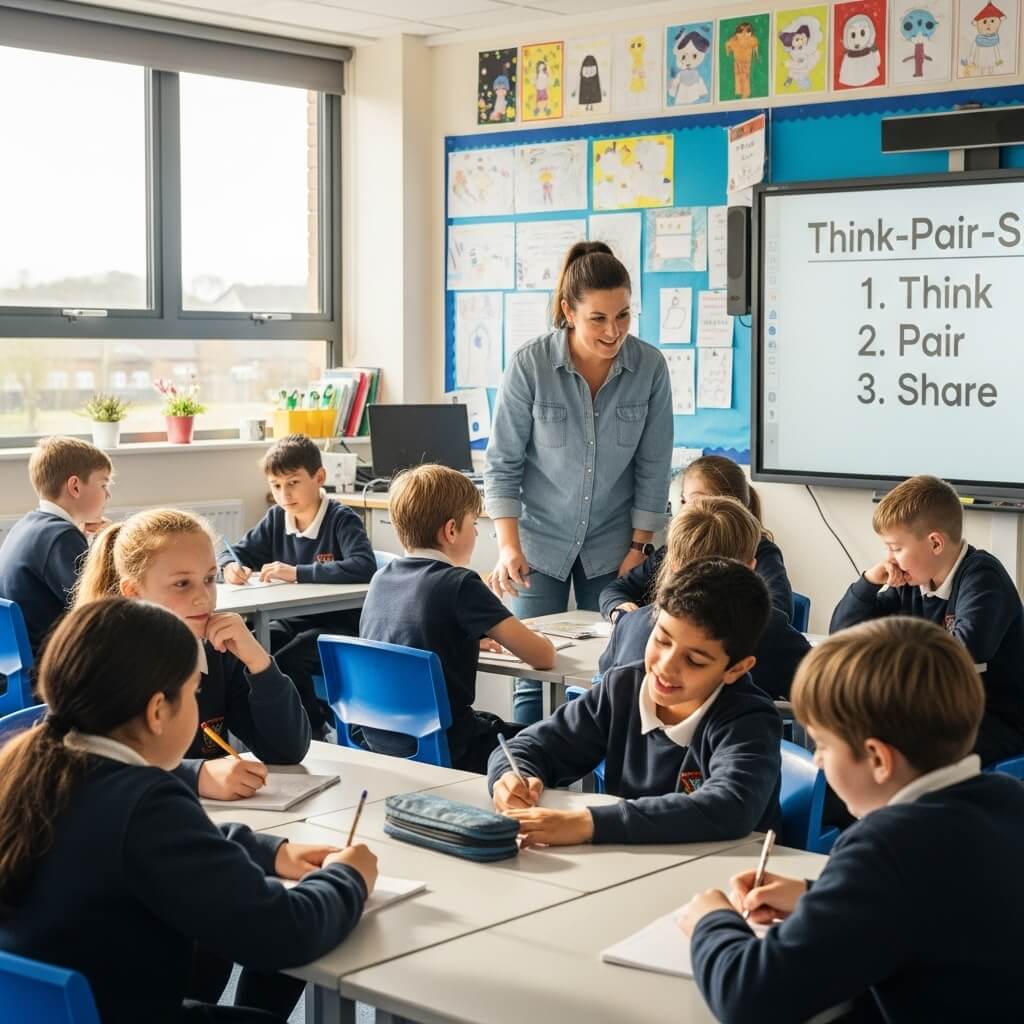
The effective implementation of thinking routines hinges on educators regarding thinking as a central pillar of learning. If teachers focus predominantly on content delivery, it can interfere with the deeper understanding that thinking routines are designed to cultivate.
Direct instruction often falls short in nurturing student understanding or encouraging independent exploration of ideas. This misalignment can lead to educators undervaluing the integration of thinking routines into their teaching practices. Additionally, the practical application of these routines can present challenges if teachers themselves are not actively engaging with and modelling these processes for students. Without this engagement, even the most thought-provoking routines can become just another checkbox to tick.
However, the true value of thinking routines is their utility across various grade levels and content areas, demanding an adaptable teaching approach to successfully develop a pervasive culture of thinking.
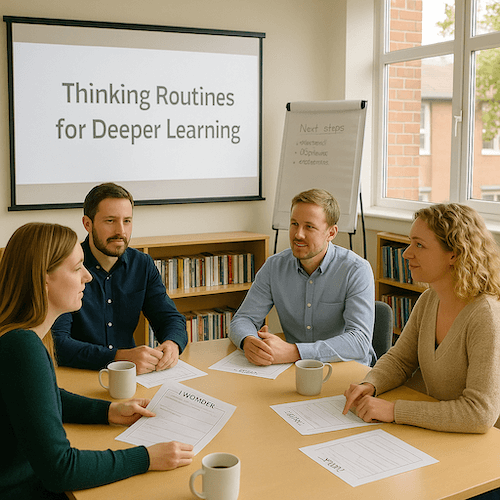
The following studies examine how Visible Thinking Strategies, simple structures, and the documentation of student thinking impact engagement, cognitive development, and classroom culture. These routines support learners in making their visual ideas and thought processes explicit, enhancing both understanding and retention.
1. Augmenting Discussion Effectiveness through the Implementation of Thinking Routines to Visualize Learners’ Cognitive Processes – Chau Thi Hong Tham (2024)
This study applied three Project Zero thinking routines (See–Think–Wonder, Headlines, Claim-Support-Question) in an English language class. It found that these routines deepened learners’ engagement, fostered self-directed learning, and improved logical thinking through visible thinking strategies and reflective dialogue.
2. Visible Thinking: Application And Evaluation Of Thinking Routines In Primary Education – Nerea Parada Rodríguez & Irene Ruiz de Galarreta Galán (2015)
This research evaluates 21 thinking routines in primary classrooms, highlighting their role as simple structures that embed cognitive routines into everyday teaching. The study shows how these tools help learners make connections and develop metacognitive awareness, aligning with Harvard Graduate School of Education goals.
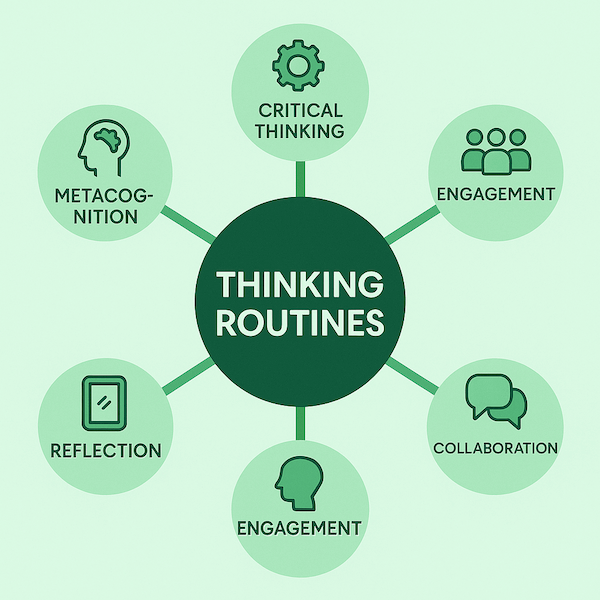
3. Thinking Routines – Rochelle Ibañez Wolberg & Allison Goff (2012)
This article discusses how Project Zero’s thinking routines encourage young children to construct meaning and monitor their thinking in both classroom and museum contexts. It emphasizes the importance of documentation of student thinking and supports the use of visual ideas to make learning visible.
4. Making Learning and Thinking Visible: An Analysis on the Use of Thinking Routines – S. Panzavolta, Elena Mosa, & Chiara Laici (2019)
Part of a national Italian study in partnership with Project Zero, this research documents the application of thinking routines across 15 secondary classrooms. The routines enhanced collaborative problem-solving, strengthened cognitive dispositions, and promoted group learning across diverse settings.
5. Evaluating the Effect of Visible Thinking Routines on Students' Awareness and Conceptions of Thinking and Understanding in the Science Classroom – I. Heredia (2017)
This action research used six thinking routines with Year 7 science students to help them distinguish between physical and cognitive actions. It confirmed that making thinking visible fosters deeper understanding and aids in transferring knowledge to new contexts—key elements of Harvard Project Zero frameworks.
It all started with Project Zero’s Visible Thinking initiative, a fascinating effort by researchers at Harvard’s Graduate School of Education. These routines have not only been instrumental but remarkably effective in nurturing student thinking across diverse backgrounds and disciplines.
While they may sound complex, these routines are essentially sets of questions or simple sequences. They scaffold and support thinking, and in time, become integral to classroom culture. This deliberate naming - thinking routines captures their essence as ingrained and socially shared practices. Their purpose? To create environments where thinking is not just encouraged but visibly celebrated and embedded in learning.
The thinking routines toolbox definines thinking routines as sequences of questions or steps that guide students in their thought processes. Intriguingly, it categorizes these routines into Core Thinking and Possibilities, along with various other methods for organizing and synthesizing ideas, creating a structured yet flexible framework.
With over 80 routines available, educators can adapt them to fit different educational settings. Think of it as a toolkit designed to make thinking more visible, encouraging a deeper connection with the content. This toolbox, a true resource by Project Zero, transforms the very fabric of classroom learning, promoting understanding and engagement.
The journey began with Project Zero researchers at Harvard’s Graduate School of Education, driven by a desire to support and scaffold student thinking. By using a set of questions or a sequence of steps, these routines make the invisible processes of thinking visible, enhancing students' cognitive abilities.
The Thinking Routines Toolbox, an integral part of this evolution, offers diverse types like Core Thinking Routines and systems for deepening student understanding. Teachers play a crucial role here, as these routines help them uncover students’ thought processes, enabling students to identify and apply specific thinking moves across various contexts.
These routines don’t just stay within the confines of a subject like English; they are versatile, fostering deeper understanding and facilitating communication across disciplines. Isn’t it fascinating how something so structured can offer such dynamic flexibility?

Thinking routines present themselves as a dynamic tool within educational settings, especially when trying to foster a culture of deeper learning and critical thinking among students. They are specifically designed to scaffold student thinking, creating avenues through which learners can explore and articulate their thoughts in varied and meaningful ways.
By employing these routines, educators can visibly illuminate the cognitive processes occurring within their classrooms, thereby allowing for a more inclusive and interactive learning environment. Adaptable across different subjects and grade levels, thinking routines offer the flexibility necessary to cater to the diverse needs of students, enhancing overall engagement and understanding.
Their structured yet flexible nature empowers students from all backgrounds and abilities to engage in open discussions and promote a culture where thinking becomes a visible and integral part of the learning process.
When we talk about enhancing critical thinking in education, the role of thinking routines becomes quite significant. These routines are meticulously crafted to make the thinking processes explicit and visible to students as they navigate through various learning challenges.
By actively participating in these thinking routines, students cultivate critical thinking skills, which are essential for analyzing complex concepts and making informed decisions. Over time, thinking routines grow alongside the student, progressively guiding them toward deeper and more advanced levels of thinking.
They provide educators with a framework to nurture a classroom atmosphere predisposed to inquiry, scrutiny, and intellectual engagement. Moreover, the flexibility of these routines means they can be applied across different subjects, ensuring that the prowess of critical thinking is a consistent thread throughout a student's learning journey.

Students who feel engaged are, in turn, more capable of exploring and reflecting on their learning experiences in a substantial way. Thinking routines serve as an essential tool in nurturing this engagement. Project Zero’s extensive research highlights their applicability across diverse age groups and academic disciplines - an important feature of these routines. By structuring student thinking toward progressively more intricate analyses, these routines invite learners to delve deeper into the learning process.
The goal here is simple yet profound: make student thinking visible. This visibility acts as a platform where students can showcase their capabilities, demonstrating not just what they know but how they think. When these routines are effectively integrated into the fabric of a classroom, they can consequently transform the cultural forces at play. There is a ripple effect - shaping language use, increasing respectful exchanges of ideas, and opening the floor to more authentic learning opportunities for every student involved.
As students use these routines, they begin to notice, understand, and consciously apply specific thinking moves, equipping them with valuable tools that can be transferred across different contexts.
The impact of successfully integrating thinking routines extends beyond mere comprehension; indeed, it fosters an educational culture where critical and creative thinking are not just encouraged but seen as everyday necessities. The scaffolding nature of these routines helps students transition from a more structured phase of thinking into a fluid, independent expression of ideas.
By emphasizing the importance of thinking beyond facts and fostering critical insights, thinking routines lay the groundwork for an enriching learning environment. Whether grappling with a mathematical concept or exploring historical narratives, these routines guide students toward a future where thinking is both visible and appreciated in every aspect of their academic journey.

Teachers who adopt Visible Thinking know that short, repeatable moves can make thinking visible, nurture positive thinking dispositions, and strengthen creative thinking skills across a wide variety of contexts. Inspired by Ron Ritchhart, these simple routines slot into any lesson, any year group, and virtually all subject matters. Below you’ll find nine of the most widely used visible thinking routines - each one a simple structure that pairs “thinking with content learning” and supports the ongoing development of students.
When embedded consistently, these Visible Thinking Strategies help cultivate Cultures of Thinking in which learners question, connect, and create—turning classrooms into communities where knowledge and thinking grow side by side.

While the routines are structured to guide thinking, they also remain adaptable, providing the flexibility needed to tie thinking directly to content and purpose. In essence, they serve as tools for achieving learning goals, rather than being objectives in themselves.
In English Language Teaching (ELT) classrooms, thinking routines are invaluable for enhancing and supporting students' learning experiences across different grades and content areas. By integrating these routines, teachers can shift the focus from mere absorption of information to fostering a deeper understanding of the material. These routines guide learners' cognitive processes through structured questions, leading to more engaging and comprehensive discussions.
As students delve into ELT resources, thinking routines help reveal and cultivate their unique thinking patterns. This insight is beneficial for both educators and students, enabling them to refine their learning strategies across various contexts. Ultimately, the consistent use of thinking routines in ELT settings encourages a culture of thoughtful inquiry and exploration.
Addressing adaptations for the writing process using thinking routines requires connecting their structured approach to creative and critical thinking. When learners embark on writing, these routines can guide brainstorming, organizing ideas, and refining drafts. The gradual and structured nature of thinking routines can help writers pause and reflect, allowing them to explore different perspectives before committing words to paper.
This is not just about producing text; it's about expanding their cognitive structures around what they wish to communicate. By focusing on the journey of writing rather than merely the destination, these routines can help develop writers who think deeply and articulate their ideas clearly, though specific adaptations still require individual exploration.

Thinking routines are particularly well-suited for online learning environments, providing a sense of structure and consistency that students can rely upon. In virtual settings, where traditional cues and interactions may be absent, these routines become a familiar anchor.
Schedules can feel disrupted online, so having a structured approach to thinking ensures that learners remain engaged, focusing on content in meaningful ways. By creating a sequence of steps or questions, they're not left aimlessly navigating unfamiliar terrain. Furthermore, teachers using these routines can gain vital insights into their students' thought processes, which are crucial for offering the right support remotely.
As students connect, question, and challenge the material presented digitally, they hone critical thinking skills in a way that mirrors, yet extends beyond, the physical classroom experience. Online, these routines help cultivate an independent yet guided form of learning.
When integrating thinking routines into classroom practice, teachers are tasked with more than just introducing a new activity or tool. They must consider both their own understanding and their students’ developmental phases. This requires an insightful approach to scaffold students' thinking effectively.
One notable challenge is ensuring that thinking routines aren't employed with material that lacks depth or relevance. Using trivial content can stifle the student's capability to engage in deeper thinking. In a successful classroom, thinking routines are not isolated add-ons. Instead, they should be thoughtfully aligned with overall learning goals to create a purposeful context that enhances understanding and exploration.
Importantly, striking the right balance between supporting students and allowing them to struggle productively is crucial. Over-scaffolding might, if unchecked, smooth out the bumps that are essential for substantive learning experiences. Appropriately, fostering a culture of thinking through routines can also bolster communication skills, underpinning students' growth in subjects such as English by facilitating more authentic and effective interactions.

The effective implementation of thinking routines hinges on educators regarding thinking as a central pillar of learning. If teachers focus predominantly on content delivery, it can interfere with the deeper understanding that thinking routines are designed to cultivate.
Direct instruction often falls short in nurturing student understanding or encouraging independent exploration of ideas. This misalignment can lead to educators undervaluing the integration of thinking routines into their teaching practices. Additionally, the practical application of these routines can present challenges if teachers themselves are not actively engaging with and modelling these processes for students. Without this engagement, even the most thought-provoking routines can become just another checkbox to tick.
However, the true value of thinking routines is their utility across various grade levels and content areas, demanding an adaptable teaching approach to successfully develop a pervasive culture of thinking.

The following studies examine how Visible Thinking Strategies, simple structures, and the documentation of student thinking impact engagement, cognitive development, and classroom culture. These routines support learners in making their visual ideas and thought processes explicit, enhancing both understanding and retention.
1. Augmenting Discussion Effectiveness through the Implementation of Thinking Routines to Visualize Learners’ Cognitive Processes – Chau Thi Hong Tham (2024)
This study applied three Project Zero thinking routines (See–Think–Wonder, Headlines, Claim-Support-Question) in an English language class. It found that these routines deepened learners’ engagement, fostered self-directed learning, and improved logical thinking through visible thinking strategies and reflective dialogue.
2. Visible Thinking: Application And Evaluation Of Thinking Routines In Primary Education – Nerea Parada Rodríguez & Irene Ruiz de Galarreta Galán (2015)
This research evaluates 21 thinking routines in primary classrooms, highlighting their role as simple structures that embed cognitive routines into everyday teaching. The study shows how these tools help learners make connections and develop metacognitive awareness, aligning with Harvard Graduate School of Education goals.

3. Thinking Routines – Rochelle Ibañez Wolberg & Allison Goff (2012)
This article discusses how Project Zero’s thinking routines encourage young children to construct meaning and monitor their thinking in both classroom and museum contexts. It emphasizes the importance of documentation of student thinking and supports the use of visual ideas to make learning visible.
4. Making Learning and Thinking Visible: An Analysis on the Use of Thinking Routines – S. Panzavolta, Elena Mosa, & Chiara Laici (2019)
Part of a national Italian study in partnership with Project Zero, this research documents the application of thinking routines across 15 secondary classrooms. The routines enhanced collaborative problem-solving, strengthened cognitive dispositions, and promoted group learning across diverse settings.
5. Evaluating the Effect of Visible Thinking Routines on Students' Awareness and Conceptions of Thinking and Understanding in the Science Classroom – I. Heredia (2017)
This action research used six thinking routines with Year 7 science students to help them distinguish between physical and cognitive actions. It confirmed that making thinking visible fosters deeper understanding and aids in transferring knowledge to new contexts—key elements of Harvard Project Zero frameworks.